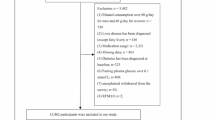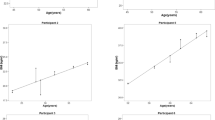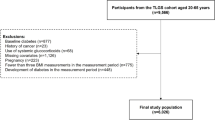Abstract
Aims and background
Relative fat mass (RFM) is strongly associated with type 2 diabetes (T2DM) and has been shown to be a better predictor than body mass index (BMI) and waist circumference (WC). This study aims to investigate the association between RFM and incident T2DM among adults in the Tehran Lipid and Glucose Study cohort.
Methods
Data from 8419 participants (4716 women; mean age, 40.52 years) were analyzed. Logistic regression was used to assess the association of RFM with insulin resistance, metabolic syndrome, and its components at baseline. Cox proportional hazards models were applied to evaluate the association between RFM and incident T2DM. Wald tests were used to compare RFM hazard ratios (HRs) with those of BMI, WC, and waist-to-hip ratio (WHR) in the Cox model.
Results
Over a median follow-up of 14 years, 1382 individuals (16.42%) developed T2DM. RFM was significantly associated with insulin resistance, metabolic syndrome, and its components at baseline in both men and women. In the multivariable-adjusted model, each standard deviation increase in RFM was associated with a 1.26-fold (1.02–1.57, P = 0.037) higher risk of T2DM in men and a 1.52-fold (1.27–1.81, P < 0.001) higher risk in women. These associations were stronger in younger individuals and remained significant only in women after adjusting for insulin resistance and restricting the analysis to normoglycemic individuals. The increased T2DM risk associated with RFM was comparable to that associated with WC in both men and women (Pdifference > 0.05).
Conclusions
While RFM is strongly associated with the risk of T2DM, particularly in women and younger individuals, it does not outperform WC.

This is a preview of subscription content, access via your institution
Access options
Subscribe to this journal
Receive 12 print issues and online access
$259.00 per year
only $21.58 per issue
Buy this article
- Purchase on SpringerLink
- Instant access to full article PDF
Prices may be subject to local taxes which are calculated during checkout



Similar content being viewed by others
Data availability
The datasets analysed during the current study are available from the corresponding author on reasonable request.
References
Sun H, Saeedi P, Karuranga S, Pinkepank M, Ogurtsova K, Duncan BB, et al. IDF Diabetes Atlas: Global, regional and country-level diabetes prevalence estimates for 2021 and projections for 2045. Diab Res Clin Pract. 2022;183:109119.
Atlas ID. IDF Atlas 10th Edition 2021, 2021; 4. Available from: https://diabetesatlas.org/atlas/tenth-edition/. Accessed May 23, 2024.
Peykari N, Mehdipour P, Larijani B, Sepanlou SG, Djalalinia S, Kasaeian A, et al. The levels and trends of diabetes prevalence at national and sub-national levels in Iran (1990–2016). J Diab Metab Disord. 2023;22:743–52.
Farzadfar F, Yousefi M, Jafari-Khounigh A, Khorrami Z, Haghdoost A, Shadmani FK. Trend and projection of non-communicable diseases risk factors in Iran from 2001 to 2030. Sci Rep. 2024;14:8092.
Ramezankhani A, Harati H, Bozorgmanesh M, Tohidi M, Khalili D, Azizi F, et al. Diabetes mellitus: findings from 20 years of the Tehran lipid and glucose study. Int J Endocrinol Metab. 2018;16:e84784.
Peimani M, Esfahani Z, Bandarian F, Esmaeili S, Moghaddam SS, Namazi N, et al. The burden of type 2 diabetes mellitus and attributable risk factors in Iran, 1990-2019: results from the global burden of disease study 2019. Iran J Public Health. 2024;53:913–23.
Ong KL, Stafford LK, McLaughlin SA, Boyko EJ, Vollset SE, Smith AE, et al. Global, regional, and national burden of diabetes from 1990 to 2021, with projections of prevalence to 2050: a systematic analysis for the Global Burden of Disease Study 2021. Lancet. 2023;402:203–34.
Abdullah A, Peeters A, de Courten M, Stoelwinder J. The magnitude of association between overweight and obesity and the risk of diabetes: a meta-analysis of prospective cohort studies. Diab Res Clin Pract. 2010;89:309–19.
Physical status: the use and interpretation of anthropometry. Report of a WHO Expert Committee. World Health Organ Tech Rep Ser. 1995;854:1–452.
Lee DH, Keum N, Hu FB, Orav EJ, Rimm EB, Sun Q, et al. Development and validation of anthropometric prediction equations for lean body mass, fat mass and percent fat in adults using the National Health and Nutrition Examination Survey (NHANES) 1999-2006. Br J Nutr. 2017;118:858–66.
Borga M, West J, Bell JD, Harvey NC, Romu T, Heymsfield SB, et al. Advanced body composition assessment: from body mass index to body composition profiling. J Investig Med. 2018;66:1–9.
Senkus KE, Crowe-White KM, Locher JL, Ard JD. Relative fat mass assessment estimates changes in adiposity among female older adults with obesity after a 12-month exercise and diet intervention. Ann Med. 2022;54:1160–6.
Jayedi A, Soltani S, Motlagh SZ, Emadi A, Shahinfar H, Moosavi H, et al. Anthropometric and adiposity indicators and risk of type 2 diabetes: systematic review and dose-response meta-analysis of cohort studies. BMJ. 2022;376:e067516.
Woolcott OO, Bergman RN. Relative fat mass (RFM) as a new estimator of whole-body fat percentage ─ A cross-sectional study in American adult individuals. Sci Rep. 2018;8:10980.
Woolcott OO, Seuring T. Temporal trends in obesity defined by the relative fat mass (RFM) index among adults in the United States from 1999 to 2020: a population-based study. BMJ Open. 2023;13:e071295.
Suthahar N, Wang K, Zwartkruis VW, Bakker SJL, Inzucchi SE, Meems LMG, et al. Associations of relative fat mass, a new index of adiposity, with type-2 diabetes in the general population. Eur J Intern Med. 2023;109:73–8.
Kobo O, Leiba R, Avizohar O, Karban A. Relative fat mass is a better predictor of dyslipidemia and metabolic syndrome than body mass index. Cardiovascular Endocrinol Metab. 2019;8:77–81.
Bozorgmanesh M, Hadaegh F, Ghaffari S, Harati H, Azizi F. A simple risk score effectively predicted type 2 diabetes in Iranian adult population: population-based cohort study. Eur J Public Health. 2011;21:554–9.
Azizi F, Ghanbarian A, Momenan AA, Hadaegh F, Mirmiran P, Hedayati M, et al. Prevention of non-communicable disease in a population in nutrition transition: Tehran Lipid and Glucose Study phase II. Trials. 2009;10:1–15.
Tohidi M, Ghasemi A, Hadaegh F, Derakhshan A, Chary A, Azizi F. Age-and sex-specific reference values for fasting serum insulin levels and insulin resistance/sensitivity indices in healthy Iranian adults: Tehran Lipid and Glucose Study. Clin Biochem. 2014;47:432–8.
Chen Y, Zhang X, Pan B, Jin X, Yao H, Chen B, et al. A modified formula for calculating low-density lipoprotein cholesterol values. Lipids Health Dis. 2010;9:1–5.
Delavari A, Forouzanfar MH, Alikhani S, Sharifian A, Kelishadi R. First nationwide study of the prevalence of the metabolic syndrome and optimal cutoff points of waist circumference in the Middle East: the national survey of risk factors for noncommunicable diseases of Iran. Diab Care. 2009;32:1092–7.
Alberti KGMM, Eckel RH, Grundy SM, Zimmet PZ, Cleeman JI, Donato KA, et al. Harmonizing the metabolic syndrome: a joint interim statement of the international diabetes federation task force on epidemiology and prevention; national heart, lung, and blood institute; American heart association; world heart federation; international atherosclerosis society; and international association for the study of obesity. Circulation. 2009;120:1640–5.
IPAQ Research Committee. Guidelines for data processing and analysis of the International Physical Activity Questionnaire (IPAQ)-short and long forms. http://www.ipaq.ki.se/scoring.pdf.2005.
Levey AS, Stevens LA, Schmid CH, Zhang Y, Castro AF, Feldman HI, et al. A new equation to estimate glomerular filtration rate. Ann Intern Med. 2009;150:604–12.
Song Y, Manson JE, Tinker L, Howard BV, Kuller LH, Nathan L, et al. Insulin sensitivity and insulin secretion determined by homeostasis model assessment and risk of diabetes in a multiethnic cohort of women: the Women’s Health Initiative Observational Study. Diab Care. 2007;30:1747–52.
Ghasemi A, Tohidi M, Derakhshan A, Hasheminia M, Azizi F, Hadaegh F. Cut-off points of homeostasis model assessment of insulin resistance, beta-cell function, and fasting serum insulin to identify future type 2 diabetes: Tehran Lipid and Glucose Study. Acta Diabetol. 2015;52:905–15.
Durrleman S, Simon R. Flexible regression models with cubic splines. Stat Med. 1989;8:551–61.
Saei Ghare Naz M, Sayehmiri F, Kiani F, Ozgoli G. A systematic review and meta-analysis on the average age of menopause among Iranian women. Evid Based Care. 2019;8:26–34.
Fine JP, Gray RJ. A proportional hazards model for the subdistribution of a competing risk. J Am Stat Assoc. 1999;94:496–509.
Klein S, Gastaldelli A, Yki-Järvinen H, Scherer PE. Why does obesity cause diabetes?. Cell Metab. 2022;34:11–20.
Smith U. Abdominal obesity: a marker of ectopic fat accumulation. J Clin Invest. 2015;125:1790–2.
Sweatt K, Garvey WT, Martins C. Strengths and limitations of BMI in the diagnosis of obesity: what is the path forward?. Curr Obes Rep. 2024;13:584–595.
Rothman KJ. BMI-related errors in the measurement of obesity. Int J Obes. 2008;32:S56–S9.
Vazquez G, Duval S, Jacobs DR Jr., Silventoinen K. Comparison of body mass index, waist circumference, and waist/hip ratio in predicting incident diabetes: a meta-analysis. Epidemiol Rev. 2007;29:115–28.
Paek JK, Kim J, Kim K, Lee SY. Usefulness of relative fat mass in estimating body adiposity in Korean adult population. Endocr J. 2019;66:723–9.
Cichosz SL, Rasmussen NH, Vestergaard P, Hejlesen O. Is predicted body-composition and relative fat mass an alternative to body-mass index and waist circumference for disease risk estimation? Diabetes & Metabolic Syndrome. Clin Res Rev. 2022;16:102590.
Wang D, Chen Z, Wu Y, Ren J, Shen D, Hu G, et al. Association between two novel anthropometric measures and type 2 diabetes in a Chinese population. Diab, Obes Metab. 2024;26:3238–47.
Chung TL, Liu YH, Wu PY, Huang JC, Chen SC. Sex difference in the associations among obesity-related indices with incidence of diabetes mellitus in a large Taiwanese population follow-up study. Front Public Health. 2023;11:1094471.
Zhang F-L, Ren J-X, Zhang P, Jin H, Qu Y, Yu Y, et al. Strong Association of Waist Circumference (WC), Body Mass Index (BMI), Waist-to-Height Ratio (WHtR), and Waist-to-Hip Ratio (WHR) with Diabetes: A Population-Based Cross-Sectional Study in Jilin Province, China. J Diab Res. 2021;2021:8812431.
Tian X, Chen S, Zhang Y, Xu Q, Xia X, Wu S, et al. Age-specific effect and pathways of risk factors on the risk of incident type 2 diabetes: a 13-year prospective cohort study. Diab/Metab Res Rev. 2025;41:e70028.
Ahlqvist E, Storm P, Käräjämäki A, Martinell M, Dorkhan M, Carlsson A, et al. Novel subgroups of adult-onset diabetes and their association with outcomes: a data-driven cluster analysis of six variables. Lancet Diab Endocrinol. 2018;6:361–9.
Gross DC, Cheever CR, Batsis JA. Understanding the development of sarcopenic obesity. Expert Rev Endocrinol Metab. 2023;18:469–88.
Moon S, Choi JW, Park JH, Kim DS, Ahn Y, Kim Y, et al. Association of appendicular skeletal muscle mass index and insulin resistance with mortality in multi-nationwide cohorts. J Cachexia Sarcopenia Muscle. 2025;16:e13811.
Luo C, Liu R-y, Zhang G-w, Hu F, Jin Y-h, Liu B-y. Possible sarcopenia and risk of new-onset type 2 diabetes mellitus in older adults in China: a 7-year longitudinal cohort study. BMC Geriatrics. 2023;23:404.
Lee HR, Shin J, Han K, Chang J, Jeong SM, Chon SJ, et al. Obesity and risk of diabetes mellitus by menopausal status: a nationwide cohort study. J Clin Med. 2021;10:5189.
Tatsumi Y, Ohno Y, Morimoto A, Nishigaki Y, Mizuno S, Watanabe S. Age differences in the risk of diabetes incidence according to body mass index level in Japanese women: BMI and diabetes in women. Obes Res Clin Pract. 2013;7:e455–e63.
Firouzi F, Ramezani Tehrani F, Kaveh A, Mousavi M, Azizi F, Behboudi-Gandevani S. Adiposity trajectories and cardiovascular disease risk in women: a population-based cohort study with a focus on menopausal status. Front Endocrinol ((Lausanne)). 2024;15:1389330.
Hedderson MM, Capra A, Lee C, Habel LA, Lee J, Gold EB, et al. Longitudinal changes in sex hormone binding globulin (SHBG) and risk of incident diabetes: the Study of Women’s Health Across the Nation (SWAN). Diab Care. 2024;47:676–82.
He L, Fan B, Li C, Qu Y, Liu Y, Zhang T. Association between body mass index and diabetes mellitus are mediated through endogenous serum sex hormones among menopause transition women: a longitudinal cohort study. Int J Environ Res Public Health. 2023;20:1831.
De Pergola G, Maldera S, Tartagni M, Pannacciulli N, Loverro G, Giorgino R. Inhibitory effect of obesity on gonadotropin, estradiol, and inhibin B levels in fertile women. Obesity. 2006;14:1954–60.
Freeman EW, Sammel MD, Lin H, Gracia CR. Obesity and reproductive hormone levels in the transition to menopause. Menopause. 2010;17:718–26.
Lr N. Estrogen production and action. J Am Acad Dermatol. 2001;45:S116–S24.
Randolph JF Jr, Zheng H, Sowers MR, Crandall C, Crawford S, Gold EB, et al. Change in follicle-stimulating hormone and estradiol across the menopausal transition: effect of age at the final menstrual period. J Clin Endocrinol Metab. 2011;96:746–54.
Cacciatore S, Calvani R, Marzetti E, Coelho-Júnior HJ, Picca A, Fratta AE, et al. Predictive values of relative fat mass and body mass index on cardiovascular health in community-dwelling older adults: Results from the Longevity Check-up (Lookup) 7+. Maturitas. 2024;185:108011.
Singh RS, Totawattage DP. The statistical analysis of interval-censored failure time data with applications. Open J Stat. 2013;3:155–66.
Bandarian F, Sharifnejad Tehrani Y, Peimani M, Namazi N, Saeedi Moghaddam S, Esmaeili S, et al. National and sub-national burden and trend of type 1 diabetes in 31 provinces of Iran, 1990–2019. Sci Rep. 2023;13:4210.
Mirbolouk M, Derakhshan A, Charkhchi P, Guity K, Azizi F, Hadaegh F. Incidence and predictors of early adulthood pre-diabetes/type 2 diabetes, among Iranian adolescents: the Tehran Lipid and Glucose Study. Pediatr Diab. 2016;17:608–16.
Acknowledgements
This article is part of a thesis done by Mr. Masrouri from the School of Medicine, Shahid Beheshti University of Medical Sciences, Tehran, Iran. We thank the research team members and TLGS participants for their valuable contributions to the study. The graphical abstract was created with BioRender.com by Dr. Amirhossein Hasanpour.
Author information
Authors and Affiliations
Contributions
SM was responsible for conceiving and designing the study. SM, NE and FH acquired, analysed and interpreted the data. NE, SM, SS, and FH were responsible for drafting the manuscript and incorporating critical revisions. All authors reviewed and approved the final manuscript.
Corresponding author
Ethics declarations
Competing interests
The authors declare no competing interests.
Ethics approval and consent to participate
The protocol of the present study, conducted in accordance with principles of the Declaration of Helsinki, was approved by the ethics committee of the Research Institute of Endocrine Sciences of Shahid Beheshti University of Medical Sciences. All participants provided written informed consent.
Additional information
Publisher’s note Springer Nature remains neutral with regard to jurisdictional claims in published maps and institutional affiliations.
Supplementary information
Rights and permissions
Springer Nature or its licensor (e.g. a society or other partner) holds exclusive rights to this article under a publishing agreement with the author(s) or other rightsholder(s); author self-archiving of the accepted manuscript version of this article is solely governed by the terms of such publishing agreement and applicable law.
About this article
Cite this article
Masrouri, S., Ebrahimi, N., Soraneh, S. et al. Association of relative fat mass with the incidence of type 2 diabetes: over a decade follow-up from the TLGS. Int J Obes (2025). https://doi.org/10.1038/s41366-025-01858-7
Received:
Revised:
Accepted:
Published:
DOI: https://doi.org/10.1038/s41366-025-01858-7



